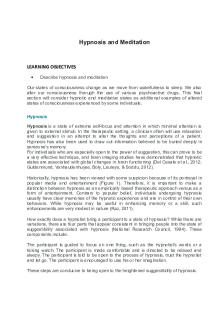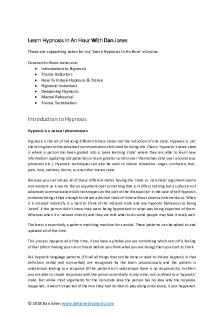Hypnosis a pseudoscience PDF

| Title | Hypnosis a pseudoscience |
|---|---|
| Course | psychology |
| Institution | Agnes Scott College |
| Pages | 2 |
| File Size | 40.6 KB |
| File Type | |
| Total Downloads | 83 |
| Total Views | 127 |
Summary
paper...
Description
Hypnosis or Mesmerism is the process of altering a state of consciousness in which a person loses the power of voluntary action and is highly responsive to suggestion or direction. Commonly it is used to create positive changes in behavior by suggesting. Although it has been reviewed and repeatedly tested by many psychologists, it is still a controversial topic in the field. The history of Hypnosis began in the late 18th century with a German physician named Franz Mesmer, he used hypnosis to treat many patients in Vienna and Paris. Over time his methods gained popularity, many physicians adopted his methods. Amongst the physicians who adopted Mesmer’s methods was an Austrian physician named Sigmund Freud who was impressed by the therapeutic potential of hypnosis for neurotic disorders. Freud utilized mesmerizing to assist hypochondriacal patients review aggravating occasions that they had clearly overlooked. As he started to create his framework of therapy, be that as it may, theoretical thought, as well as the trouble he experienced in hypnotizing a few patients, driven Freud to dispose of trance in favor of the free association. After that various researchers have put forth differing theories of what hypnosis is and how it might be understood, but there is still no generally accepted explanatory theory for the phenomenon. Hypnosis is, maybe, one of the foremost misconstrued and questionable strategies of psychological treatment. The myths and misinterpretations that encompass hypnotherapy generally stem from people’s thoughts around arranged sleep induction. The truth is that organized sleep induction is basically a dramatic execution and has around as much in common within good faith clinical entrancing as numerous Hollywood motion pictures have with life. In reality, however, that entrancing may be a veritable mental phenomenon that has real employments in clinical hone. Basically put, trance may be a state of profoundly centered consideration or concentration, regularly related to unwinding, and increased suggestibility.
Whereas beneath trance (i.e., in a trance-like stupor), it appears many people are much more open to accommodating recommendations than they more often than not are. Despite its many success in other studies, there is a study that shows that hypnosis may not be applicable to all people. The central point of hypnosis is based on the suggestibility of an individual in a trance-state. While in this state suggestions by the hypnotist are expected to induce a range of psychological, sensory, and motor responses from persons who are deeply hypnotized, there are multiple cases when an individual does not become completely hypnotized, showing that the hypnotic state is not always probable for all people. This may be due to various factors such as brain physiological differences that can prevent the hypnotic state(Stanford Medicine, 2012). Which led many to question the scientific basis of hypnosis since the data from hypnotic researches can not reliably be reproduced in some cases. In a research study, it shows that one-quarter of the patients they tested cannot be hypnotized. The data showed that though a person’s hypnotizability is not linked with any specific personality trait it can be attributed to brain physiology....
Similar Free PDFs

Hypnosis a pseudoscience
- 2 Pages

Hypnosis Quiz - QUIZ
- 3 Pages

11. Hypnosis
- 3 Pages

Tutorial Hypnosis
- 5 Pages
![Pseudoscience Activity[ 825]](https://pdfedu.com/img/crop/172x258/m6rmpek07drp.jpg)
Pseudoscience Activity[ 825]
- 1 Pages

1.2 Psychological Pseudoscience
- 5 Pages

The Stage Hypnosis Guide (Autosaved)
- 56 Pages

Hypnosis and Meditation
- 3 Pages

4. Hypnosis - Lecture notes 4
- 18 Pages
Popular Institutions
- Tinajero National High School - Annex
- Politeknik Caltex Riau
- Yokohama City University
- SGT University
- University of Al-Qadisiyah
- Divine Word College of Vigan
- Techniek College Rotterdam
- Universidade de Santiago
- Universiti Teknologi MARA Cawangan Johor Kampus Pasir Gudang
- Poltekkes Kemenkes Yogyakarta
- Baguio City National High School
- Colegio san marcos
- preparatoria uno
- Centro de Bachillerato Tecnológico Industrial y de Servicios No. 107
- Dalian Maritime University
- Quang Trung Secondary School
- Colegio Tecnológico en Informática
- Corporación Regional de Educación Superior
- Grupo CEDVA
- Dar Al Uloom University
- Centro de Estudios Preuniversitarios de la Universidad Nacional de Ingeniería
- 上智大学
- Aakash International School, Nuna Majara
- San Felipe Neri Catholic School
- Kang Chiao International School - New Taipei City
- Misamis Occidental National High School
- Institución Educativa Escuela Normal Juan Ladrilleros
- Kolehiyo ng Pantukan
- Batanes State College
- Instituto Continental
- Sekolah Menengah Kejuruan Kesehatan Kaltara (Tarakan)
- Colegio de La Inmaculada Concepcion - Cebu






